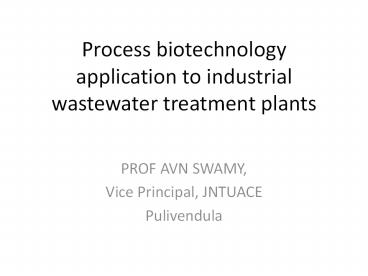Process biotechnology application to industrial wastewater treatment plants - PowerPoint PPT Presentation
1 / 15
Title:
Process biotechnology application to industrial wastewater treatment plants
Description:
Process biotechnology application to industrial wastewater treatment plants ... ZeeWeed ultrafiltration membranes are immersed in an aeration tank, ... – PowerPoint PPT presentation
Number of Views:435
Avg rating:3.0/5.0
Title: Process biotechnology application to industrial wastewater treatment plants
1
Process biotechnology application to industrial
wastewater treatment plants
- PROF AVN SWAMY,
- Vice Principal, JNTUACE
- Pulivendula
2
Clarifier
3
Anaerobic Digester
4
Typical clarifier
5
PPS compact clarifier
6
Typical ETP flow sheet
7
Aeration tank-Diffused aeration
8
Bioeactors
9
- This unique stand-alone Bioreaction system can be
placed into almost any Hydrokleen wastewater
treatment system. This unit will dramatically
assist existing treatment systems. The HE-BR-500
can be added to any system where light
hydrocarbons, high concentrations of oils and
grease, antifreeze, pesticides, organic nitrogen
and other liquids are a problem.
10
Moving bed Bioreactor
- As contaminated water enters the Bioreactor it is
slowed down to allow for solids to fall to the
bottom of the tank and evenly coat the biomass.
Being a moving bed reactor the biomass is
systematically rotated allowing all portions of
the media to be exposed to the influent. These
provide the biodigesters an unlimited surface
area for bio-reaction to occur. Pre-packaged in a
liquid form, the Hydro-Biodigesters are dispensed
automatically into the biomass. Automatic dosing
allows precise use of the biological product for
maximum digestion of waste. Water passes from the
system automatically where it can be discharged
for reuse or sanitary sewer. Head pressure purges
the accumulated sludge, eliminating the
requirement to manually remove solids. - Dual 5500 gallon Bioreactors for use in high-flow
wastewater recycling or pre-treatment for
discharge to sanitary sewer. Bioreaction take
time, the flow rate and substrate to be broken
down determine the size of the system. This big
guy is 5500 gallons. The 5500 can be set up to
break down hydrocarbons, high concentrations of
oils and grease, antifreeze, pesticides, organic
nitrogen and other organics. Contact us for a
quote on your requirement.
11
Airlift eactors
- Since one of the recognized characteristics of
- airlift reactors is the potential for scaling up
and - the relatively low power consumption for
agitation - and oxygenation, it is only natural that many
- processes related to wastewater treatment use
this - type of reactors.
- Jin et al. (2002) used an airlift reactor in a
- comprehensive pilot plant system for starch
- processing wastewater reclamation. The starch was
- utilized by Aspergilius orizae. Simultaneously to
a - 95 COD, 93 BOD and 98 suspended solids
- removal, an important production of ??-amylase
- (50 EU/ml) was obtained (Jin et al. 1998). An
- interesting point in this paper is the dependence
of - fungal morphology on ALR fluid dynamics. In this
- type of processes, morphology of the fungal
- biomass is extremely important. Free mycelial
- growth (wild growth) increases strongly the
- viscosity, limiting the oxygen transfer rate from
12
- The solution that has been
- almost universally adopted for this problem,
which - attains to citric and other organic acids,
- antibiotics, etc., is to find the conditions
under - which the biomass takes the form of fungal
pellets. - The advantage in gas-liquid transfer rate because
- of the decrease in viscosity usually overweighs
the - added resistance stemming from the itraparticle
- diffusion of oxygen. But the formation of pellets
in - optimal size and compactness is a very complex
- matter.
13
MBR GE
- The ZeeWeed membrane bioreactor (MBR) process is
a GE technology that consists of a suspended
growth biological reactor integrated with an
ultrafiltration membrane system, using the
ZeeWeed hollow fiber membrane. Essentially, the
ultrafiltration system replaces the solids
separation function of secondary clarifiers and
sand filters in a conventional activated sludge
system. - ZeeWeed ultrafiltration membranes are immersed in
an aeration tank, in direct contact with mixed
liquor. Through the use of a permeate pump, a
vacuum is applied to a header connected to the
membranes. The vacuum draws the treated water
through the hollow fiber ultrafiltration
membranes. Permeate is then directed to
disinfection or discharge facilities.
Intermittent airflow is introduced to the bottom
of the membrane module, producing turbulence that
scours the external surface of the hollow fibers.
This scouring action transfers rejected solids
away from the membrane surface.
14
MBR
- ZeeWeed membrane bioreactor technology
effectively overcomes the problems associated
with poor settling of sludge in conventional
activated sludge processes. ZeeWeed MBR
technology permits bioreactor operation with
considerably higher mixed liquor solids
concentrations than conventional activated sludge
systems that are limited by sludge settling. The
ZeeWeed MBR process is typically operated at a
mixed liquor suspended solids (MLSS)
concentration in the range of 8,000 to 10,000
mg/L. Elevated biomass concentrations allow for
highly effective removal of both soluble and
particulate biodegradable material in the waste
stream. The ZeeWeed MBR process combines the unit
operations of aeration, secondary clarification
and filtration into a single process, producing a
high quality effluent, simplifying operation and
greatly reducing space requirements.
15
(No Transcript)































